
Lunch is hours away, but your stomach is already growling. You’re contemplating snatching a candy bar out of the machine, but the guilt is too much to bear. If you think that your best option is to avoid a snack altogether and wait for the next meal, think again.
One of the biggest myths about snacking is that it is an unhealthy habit. The truth is that it’s not snacking that is bad, but rather the type of food and quantities that people choose. In fact, snacking might be the missing ingredient that will help you reach your optimum health goal.
Healthy snacking can boost energy levels while providing the proper nutrients and also satisfying hunger. You don’t need to avoid snacks altogether. Instead, plan them with moderation and variety in mind.
The Benefits of Snacks
Although you may feel guilty about snacking, it can be beneficial to eat several small meals a day instead of large meals just a few times a day. Here’s how healthy snacking can help you:
- More satisfaction from fewer calories. Snacking often can help people meet their nutritional needs without gaining the added calories.
- Prevent overeating. Snacking between meals can actually reduce your overall caloric intake by controlling the feeling to binge at your next meal.
- Boost of energy and nutrients. Healthy snacks provide fiber and nutrients your body needs to keep you energized throughout the day.
Make Snacks a Healthy Part of Your Life
The challenge with snacking is not when or how often you snack. The real challenge is what kind of food you eat and how much. There are many easy ways to incorporate snacking into a healthy lifestyle. Here are some tips to make snacking work for you:
- Avoid consistent snacking of foods that are high in sugar, salt and fat. Snacks such as candy, potato chips and soda tend to have little or no nutritional value, but they can be okay, once in a while.
- Eat slowly and make the first bite count. Research has shown it takes approximately 12 minutes for food satisfaction signals to reach the brain of a thin person, and roughly 20 minutes for an overweight person. Eating slowly guarantees that these messages have time to reach the brain in order to prevent overeating.
- Be aware. Avoid eating snacks in front of the television, computer or while driving. When we are distracted our brains tend to not recognize the food we have eaten.
- Moderation. The key to healthy snacking is to eat more frequent, yet small portions. Buy small packages of food to avoid binge eating and don’t snack out of the box. The temptation to polish off the package is just too great.
- Always have snacks available. Keep healthy snacks like dried fruit or raisins in a desk drawer, carrots or fresh fruit in the kitchen refrigerator at work or even nuts in the car, so when cravings arise you won’t visit the candy machine.
- Only snack if you are hungry. The point of healthy snacking is to quench hunger while being health conscious, so don’t snack if you aren’t really hungry. A leading cause of overeating happens because of boredom or social eating, so be careful not to fall into this trap.
With proper portions and healthy food choices, snacking can enhance, rather than hurt your diet.



 Posted by Stroller Strides of North San Antonio
Posted by Stroller Strides of North San Antonio 

 Set a positive example by leading an active lifestyle yourself.
Set a positive example by leading an active lifestyle yourself.


 Game On! Let’s have a game night with appetizers, desserts and drinks! Bring your fav. board game over and something to share! Please post game and food/drink you are planning to bring. See you there! DATE HAS CHANGED TO JULY 7th
Game On! Let’s have a game night with appetizers, desserts and drinks! Bring your fav. board game over and something to share! Please post game and food/drink you are planning to bring. See you there! DATE HAS CHANGED TO JULY 7th


